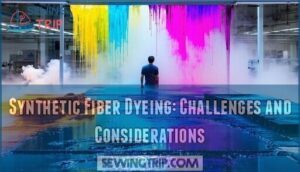This site is supported by our readers. We may earn a commission, at no cost to you, if you purchase through links.

For painting, use flexible fabric paints that won’t crack when stretched – acrylic paints with fabric medium work well.
When dyeing, hot water dye baths with powdered synthetic dyes give the best results, though you’ll need about 30 minutes of heat treatment.
Bleaching neoprene is trickier since it’s synthetic, but diluted bleach solutions can lighten darker colors gradually.
Always test your chosen method on a hidden area first, and remember that neoprene’s stretchy nature means your coloring agent needs flexibility too.
The secret lies in understanding which products actually bond with synthetic rubber materials.
Table Of Contents
- Key Takeaways
- Dyeing Neoprene Fabric
- How to Dye Neoprene Seat Covers
- Tips for Dyeing Neoprene Clothing
- Painting Neoprene: Best Practices
- Bleaching Neoprene: is It Possible?
- Can Neoprene Resist Bleaching?
- Effects of Bleach on Neoprene
- Preventing Neoprene Fading
- Synthetic Fiber Dyeing: Challenges and Considerations
- Techniques for Bleaching Fabric
- Frequently Asked Questions (FAQs)
- Conclusion
Key Takeaways
- Test first, commit second – Always try your chosen coloring method on a hidden area before treating the entire piece, since neoprene’s unpredictable nature means you cannot guarantee results and mistakes are permanent.
- Choose flexible products – Use paints with fabric medium, synthetic-blend dyes, or specialized neoprene paints to prevent cracking when the material stretches, as regular paints will fail on rubber surfaces.
- Skip bleach entirely – Bleaching destroys neoprene’s molecular structure, causing cracking, brittleness, and permanent damage that outweighs any color benefits you might achieve.
- Work light to dark only – You cannot lighten neoprene colors, so plan your project accordingly and start with the lightest base color possible for your desired final result.
Dyeing Neoprene Fabric
Neoprene dyeing requires patience since this synthetic material resists color changes more stubbornly than cotton or wool.
Start with a small test patch to avoid ruining your entire project—neoprene’s unpredictable nature means you can’t guarantee results.
Choose synthetic-blend dyes designed for neoprene treatment, as standard fabric dyes produce weak, uneven coloring.
Mix dark-colored powdered dye with hot water for better dye penetration, but avoid boiling temperatures that damage the material’s structure.
Soak your neoprene in warm water before adding it to the washing machine, then run an extended cycle while delaying the rinse for thirty minutes.
This extra time helps the neoprene coloring process work more effectively.
Remember, you can only dye from light to dark colors—there’s no going backward with neoprene color changes.
Skip bleach entirely since it weakens the fibers and causes cracking.
How to Dye Neoprene Seat Covers
Seat cover dyeing requires careful preparation and the right materials to achieve lasting color changes. You’ll want to start with plain or off-white neoprene covers since you can’t lighten dark colors – only go from light to dark.
Here’s your roadmap to successful neoprene dyeing:
- Mix dark-colored powdered dye with 2 cups of hot water for maximum color saturation
- Soak covers in hot water before adding to your washing machine for better dye penetration
- Run an extended wash cycle, delaying the rinse for 30 minutes to lock in color
Fabric preparation makes all the difference in neoprene treatment. Test a small hidden area first because results can be unpredictable with this synthetic material. Use synthetic blend dyes like Rit DyeMore for better penetration into the rubber fibers. The dye selection process matters – standard fabric dyes often produce pale, uneven results on neoprene.
Remember that neoprene coloring works best on blends rather than pure neoprene. After dyeing neoprene, rinse thoroughly in warm then cold water until it runs clear, then hang to dry. This process requires careful preparation and the right materials to achieve lasting color changes. Always choose the right dye for the job and follow the instructions carefully to ensure a successful outcome with better dye penetration and maximum color saturation.
Tips for Dyeing Neoprene Clothing
Coloring clothing made from neoprene requires a different approach than standard seat covers. While seat covers offer flat surfaces for even dye application, garments present complex curves and seams that make consistent results nearly impossible.
**Test compatibility.
**Not all dyes work well on neoprene. Do samples first.
**Mind the heat.
**Neoprene can be damaged by high temperatures during dyeing.
**Prep it right.
**Clean neoprene and use adhesion promoters before painting.
Neoprene Care becomes critical when working with clothing since flexibility must be maintained. Dye Selection for garments should focus on synthetic-blend formulas that won’t crack with movement. Color Theory suggests choosing darker shades over pastels for better penetration. Fabric Prep involves thorough cleaning before any dyeing neoprene attempts. Safety Measures include testing small areas first, as mistakes can’t be undone once neoprene paint dye soaks in.
- Always buy pre-colored garments when possible – dyeing neoprene fabric rarely produces professional-looking results on complex clothing shapes.
Skip bleach entirely, as it weakens the material’s protective qualities over time.
Painting Neoprene: Best Practices
Painting neoprene requires careful paint selection since the material’s rubber content makes it reject many standard paints.
You’ll need compatible options like Puffy Paint, Plasti Dip, or acrylic paint mixed with textile medium to guarantee proper adhesion and flexibility.
Compatible Paint Brands
Looking for the right paint brands?
Monster Makers Rubber Mask Paint delivers top-tier flexibility for neoprene projects.
Plasti Dip provides decent coverage through multiple coats.
Acrylic paint works when mixed with fabric medium for stretch tolerance.
Oil based options exist but risk cracking.
Puffy Paint and neoprene sprays offer user-friendly alternatives for beginners.
For a highly flexible finish, consider using flexible paint options to achieve the desired results.
Preparing Neoprene for Painting
Why skip the prep work when proper surface preparation makes all the difference? Your paint job’s success hinges on these essential steps:
- Surface Prep: Clean thoroughly with mild soap and water
- Neoprene Cleaning: Remove oils, dirt, and residue completely
- Material Priming: Apply urethane cure accelerator as primer
- Paint Adhesion: Allow accelerator to penetrate fabric deeply
- Flexibility Testing: Test small area before full application
This paint preparation creates the perfect foundation for neoprene customization. Skip these steps, and you’ll watch your fabric preparation efforts peel away.
Using the right urethane primer products is essential for a successful paint job.
Drying Time and Protective Coating
Most neoprene paint reaches touch-dry within 20 minutes, but you’ll need patience for the full cure. Wait 24-48 hours before applying protective coating to prevent color bleeding or adhesion issues.
This timing guarantees maximum color durability and bleach resistance for your finished project. When working with neoprene, consider the paint compatibility issues to achieve the best results.
| Drying Methods | Curing Times |
|---|---|
| Touch dry | 20 minutes |
| Hard dry | 2-4 hours |
| Full cure | 24-48 hours |
| Protective coating ready | 48+ hours |
Choose polyurethane or liquid rubber sealants for best finish options and long-term protection.
Bleaching Neoprene: is It Possible?
Bleaching neoprene isn’t the transformation magic you might expect—it’s actually a chemical demolition project.
Neoprene fights back against bleach like armor against arrows—expect destruction, not transformation.
While bleach can create color changes, it simultaneously destroys the material’s structural integrity through polymer bond disruption. The sodium hypochlorite in bleach causes immediate fading and permanent damage that can’t be reversed.
Here’s what happens when you bleach neoprene:
- Bleach Effects create patchy, uneven discoloration instead of uniform lightening
- Neoprene Damage includes cracking, brittleness, and loss of flexibility
- Color Fading occurs rapidly but compromises the rubber surface permanently
- Material Safety becomes questionable as bleach weakens molecular bonds
- Chemical Reactions accelerate aging and reduce moisture resistance
- Bleach Resistance in neoprene is virtually nonexistent due to its synthetic rubber composition
Professional wetsuit manufacturers universally advise against bleaching techniques because the structural damage outweighs any aesthetic benefits. Understanding proper leather bleaching methods can help individuals appreciate the complexity of working with different materials and their unique responses to chemical treatments.
Can Neoprene Resist Bleaching?
Unfortunately, neoprene doesn’t resist bleaching like many believe. Contrary to popular myths, bleach effects on neoprene are severe and immediate.
Sodium hypochlorite causes rapid material degradation, breaking down molecular bonds within minutes. You’ll notice color fading first, followed by structural weakness.
Even oxygen bleach creates neoprene damage over time. Chemical resistance in neoprene is limited when facing harsh oxidizers.
Bleaching techniques that work on cotton will destroy neoprene fibers completely. Your best bet? Skip neoprene bleaching entirely and choose safer cleaning methods instead.
Understanding bleach resistant fabrics is vital to avoiding similar damage to other materials.
Effects of Bleach on Neoprene
When bleach meets neoprene, you’re witnessing chemical warfare at the molecular level.
**Bleach doesn’t discriminate—it destroys neoprene’s strength while stripping its color.
The sodium hypochlorite in bleach doesn’t just change color—it attacks the polychloroprene polymer chains that give neoprene its strength and flexibility.
Here’s what happens during this chemical battle:
- Material Weakening – Bleach breaks down the molecular bonds, making your neoprene brittle like old rubber bands
- Color Fading – Even jet-black neoprene turns brown or yellow as the dye molecules get destroyed
- Chemical Reactions – The chlorine creates irreversible damage that spreads beyond the initial contact area
This neoprene degradation happens fast—sometimes within minutes of contact.
You’ll notice the texture becoming rough and chalky where bleach touched it.
The material loses its waterproof qualities and stretchy feel permanently.
Understanding nylon fabric risks is essential to appreciate the potential damage bleach can cause to similar synthetic materials.
While bleaching techniques might seem tempting for dyeing projects, the bleach damage far outweighs any color benefits.
Your wetsuit or seat covers won’t just look different—they’ll perform poorly and tear easily after exposure.
Preventing Neoprene Fading
Since sunlight acts like a slow poison for neoprene, protecting your gear from UV damage becomes essential for color preservation. UV protection starts with understanding that neoprene’s molecular structure breaks down when exposed to ultraviolet rays, causing permanent fading and material weakening.
Store your items in dark, cool spaces whenever possible. Apply UV-resistant sprays designed for synthetic materials every few months. When using neoprene outdoors, seek shade during peak sun hours.
Regular cleaning removes salt, chlorine, and other chemicals that accelerate UV damage. If you’re storing seat covers or wetsuits in vehicles, use window tinting and dashboard covers to reduce interior UV exposure.
Cover equipment with protective tarps or specialized neoprene covers when not in use. These simple steps create a barrier against fading prevention challenges while maintaining your investment’s appearance and functionality for years.
Synthetic Fiber Dyeing: Challenges and Considerations
When you’re working with synthetic materials like neoprene, you’ll face unique challenges that don’t exist with natural fibers.
The synthetic polymer structure resists traditional fabric dyes and requires specialized techniques to achieve lasting color changes.
Stovetop Method for Dyeing
Your best bet for dyeing neoprene fabric successfully lies in mastering the stovetop method. Fill a large stainless steel pot with three gallons of water per pound of fabric, then heat to 200°F.
Maintaining proper dye temperature throughout the process guarantees deep color depth penetration into synthetic fibers. Add your dye concentrate to simmering water before introducing pre-dampened neoprene.
Practice heat control by keeping temperatures consistent – synthetic materials won’t accept dye without sustained high heat. This methodical approach prevents the patchy results you’d get from rushed techniques.
Using a stovetop dye kit can help achieve professional-looking results.
Overdyeing Existing Colors
Overdyeing existing colors on neoprene creates unexpected results as new dyes blend with original hues.
You can’t predict the final shade when darkening existing colors through overdye methods. The color shift depends on your base color and chosen dye.
Dark blues mixed with red create muddy purples, while light colors offer better color correction opportunities.
This unpredictability makes fade prevention planning essential before dyeing neoprene fabric, as bleach dye effects compound the complexity of color dye neoprene projects.
Impact of Sun and Bleach Damage
After prolonged exposure to harsh elements, your neoprene faces an uphill battle against permanent damage.
Sun damage and bleach effects create three major restoration challenges:
- Color fading strips away original pigments completely
- Material degradation weakens fiber structure permanently
- UV protection loss reduces neoprene durability substantially
Bleach damage breaks molecular bonds, while sun damage causes brittleness.
Color restoration becomes nearly impossible once structural integrity fails—replacement often beats repair.
Techniques for Bleaching Fabric
Bleaching neoprene isn’t recommended because bleach weakens the material and causes permanent damage.
You can use safer alternatives like vinegar solutions or diluted oxygen bleach for cleaning, but true bleaching that lightens color won’t work without destroying the fabric, which is why safer alternatives are preferred.
Basic Supplies and Optional Tools
Before you start bleaching neoprene fabric, gather your Tool Kits and prepare your workspace.
You’ll need these basic Dye Materials for safe and effective bleach application:
- Rubber gloves – Protect your hands from harsh chemicals
- Plastic sheeting – Cover surfaces to prevent damage
- Ventilation fan – Provide proper airflow during Fabric Prep
- Neutralizing agent – Stop bleach action when you’re done
Remember that bleach affects neoprene differently than regular fabric, so proper preparation prevents costly mistakes.
When working with chemicals, it’s vital to regard rubber glove safety to prevent skin irritation.
Bleaching Techniques
Pattern-making transforms plain neoprene into artistic masterpieces through strategic bleach resistance techniques.
You’ll create stunning designs using rubber bands, string, or elastic to bind fabric sections before bleaching.
Test dilution ratios on swatches first – start with 1:10 bleach-to-water mixtures.
Verify proper ventilation needs are met during exposure time.
Consider bleach alternatives for neoprene since traditional methods often fail.
Apply bleach safety measures for neoprene throughout the process, understanding bleach effects on neoprene fabric beforehand for superior results.
Rinse and Neutralizing Process
Once you’ve finished bleaching, it’s time to halt the dyeing process and protect your neoprene.
The water rinse and neutralizing steps prevent ongoing damage while stabilizing your results.
Here’s your rinse process roadmap:
- Cold Water Rinse – Immediately plunge the fabric into cold water, agitating gently to flush out residual bleach and stop the color restoration process
- Neutralizing Agents Bath – Create a solution using white vinegar or sodium thiosulfate to balance pH and prevent further neoprene dye breakdown
- Final Fabric Soaking – Allow extended contact time with the bleach neutralizing solution for complete color stabilization and dye fixing
This methodical approach guarantees your neoprene won’t continue deteriorating after treatment.
Frequently Asked Questions (FAQs)
Will bleach damage neoprene?
Yes, bleach will damage neoprene.
It weakens the material by breaking down molecular bonds, causing discoloration and structural degradation.
Even diluted bleach solutions harm neoprene fibers.
Use vinegar instead for safer cleaning.
Can you dye wetsuit material?
Dyeing wetsuit neoprene is like swimming against a strong current—you can make progress, but it takes determination.
You’ll have better luck with nylon-blend wetsuits than pure neoprene, using synthetic dyes in hot water.
Can neoprene be painted?
You can paint neoprene, but it’s tricky.
The rubber soaks up paint immediately, making mistakes permanent.
Use thin coats of flexible paints like Puffy Paint, Plasti Dip, or acrylics mixed with textile medium for best results.
What can you use to write on neoprene?
You can write on neoprene using Puffy Paint, Trident’s U-Mark-It markers, or acrylic paint mixed with Ceramcoat Textile Medium.
These materials penetrate neoprene’s porous surface immediately, so work carefully—mistakes can’t be undone once absorbed, as they are immediately absorbed into the neoprene, making it important to use carefully.
What solvents help remove paint from neoprene?
Acetone and rubbing alcohol work best for stripping paint from neoprene.
Start with isopropyl alcohol, then try acetone if needed – but test first on hidden areas since solvents can damage neoprene.
How does neoprene thickness affect coloring results?
Thicker neoprene requires more paint or dye penetration time and multiple coats to achieve even coverage.
You’ll need stronger concentrations and longer processing times compared to thinner materials for consistent results.
Can heat guns speed up dye penetration?
Need to speed up your dye job?
Heat guns won’t help here. They’ll actually damage neoprene’s structure and create uneven color patches.
Stick to hot water soaking for thirty minutes instead—it’s safer and more effective.
What primer works best for neoprene painting?
Urethane cure accelerator works best as a primer for neoprene painting.
It prepares the material’s surface and dramatically improves paint adhesion.
Apply it before using compatible paints like Puffy Paint or diluted acrylics.
Does chlorinated water damage colored neoprene permanently?
Yes, chlorinated water permanently damages colored neoprene.
Chlorine breaks down the rubber’s molecular structure, causing fading, discoloration, and material degradation that can’t be reversed.
Even dark neoprene becomes structurally weakened after chlorine exposure.
Conclusion
Successfully coloring neoprene starts with selecting the right technique for your specific project.
Whether you choose to paint, dye, or bleach, remember that flexibility and compatibility are essential factors.
Always test your method on a hidden area first, prepare your workspace properly, and allow adequate drying time.
With patience and the proper materials, you can transform your neoprene items effectively, and the key to mastering how to color neoprene paint dye bleach methods lies in understanding which products bond best with synthetic rubber materials.
- https://www.youtube.com/watch?v=Lx0JbSpRyNE
- https://www.reddit.com/r/scuba/comments/17si8le/best_way_to_dye_a_wetsuit/
- https://www.ritdye.com/instructions/how-to-use-dyemore-for-synthetic-fibers/
- https://alchemy.gr/post/839/how-to-clean-the-mold-off-your-freediving-neoprene-wetsuit
- https://foxandottercreations.com/tutorials/2018/12/7/walkthrough-of-sapphire-tail-puffy-paint-neoprene-spandex-and-craft-foam
















